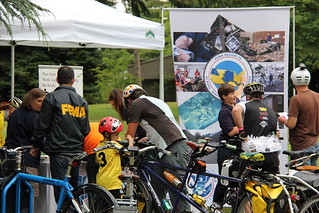Jun
25

Posted by Maddie Romansic on June 25th, 2013
Posted in: Emergency Preparedness, News From NNLM PNR
Hi! I’m Madelena Romansic, the Program Assistant since December at the NN/LM PNR.
I recently participated in Seattle’s first Disaster Relief Trials (DRTs), held at the University of Washington as part of the Bicycle Urbanism Symposium. Inspired by an annual event of the same name in Portland, OR, Seattle’s DRTs illustrated the unique advantages of bicycles for providing aid in emergency situations, and showcased their cargo-hauling capabilities.

FEMA at Seattle DRT station 2, photo courtesy Fred Bretsch
More than forty participants attended the event, having enrolled in one of two classes. About half rode as cargo cyclists who were given eggs to carry, simulating fragile medicine vials, and tasked with accumulating 100 pounds of emergency supplies at four checkpoints over the ten mile course. Over the course of the competition, they had to portage their bike and supplies over a meter-high barrier, and navigate through six-inch-deep water in the University of Washington marshland.

Two cargo-laden riders in the UW marsh
Since I don’t have a cargo bike, I rode in the other class as a civilian/support bike. Cargo cyclists and civilians alike had to navigate rough terrain, stopping at all four checkpoints, gaining emergency response skills such as how to fashion a tourniquet with a tie or belt, how to splint a broken arm with cardboard, and how to staunch bleeding with disposable diapers or sanitary pads.
The first cargo cyclist to return made the full 10 mile trip, laden with 100 pounds of supplies, in an impressive 49 minutes.
For more information you can visit http://seattledrt.wordpress.com/
To see Q13’s coverage of the event, here is a short video: http://q13fox.com/2013/06/21/bike-heroes-prepare-for-disaster/. As their report mentions, in Hurricane Sandy, bicycles were integral in transporting lifesaving supplies, and even medics, to people who couldn’t be reached by other vehicles.
One thing I liked so much about this ride was that it was very accessible. People of all ages and varying degrees of fitness were in attendance. The competition was friendly, and there was barely any spandex to be seen! It was very empowering and inspiring to see what a normal person can accomplish with a bicycle.
I’m so glad I attended this event, and hope to do so again next year! I felt that the DRTs were not only a great way to network with other bike enthusiasts who feel like heroes who can save the world, but a great reminder to everyone of how effective bicycles can be in adverse conditions, and how they should not be overlooked as an important part of a city’s disaster plan.
 ABOUT Maddie Romansic
ABOUT Maddie Romansic